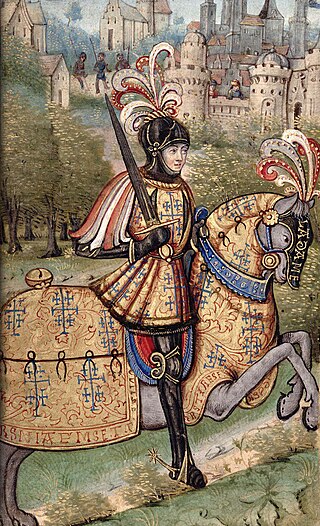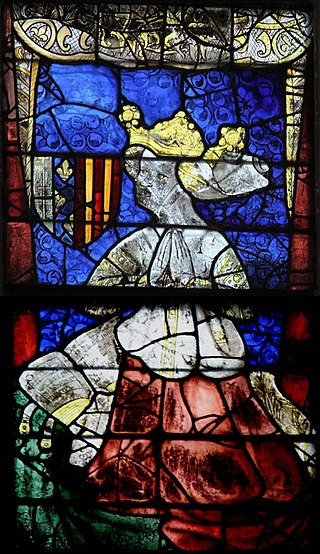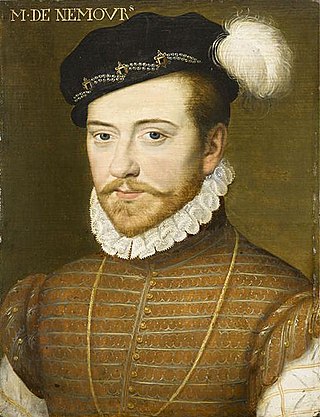Related Research Articles

The House of Bourbon is a dynasty that originated in the Kingdom of France as a branch of the Capetian dynasty, the royal House of France. Bourbon kings first ruled France and Navarre in the 16th century. A branch descended from the French Bourbons came to rule Spain in the 18th century and is the current Spanish royal family. Further branches, descended from the Spanish Bourbons, held thrones in Naples, Sicily, and Parma. Today, Spain and Luxembourg have monarchs of the House of Bourbon. The royal Bourbons originated in 1272, when Robert, the youngest son of King Louis IX of France, married the heiress of the lordship of Bourbon. The house continued for three centuries as a cadet branch, serving as nobles under the direct Capetian and Valois kings.

René of Anjou was Duke of Anjou and Count of Provence from 1434 to 1480, who also reigned as King of Naples as René I from 1435 to 1442. Having spent his last years in Aix-en-Provence, he is known in France as the Good King René.

René II was Count of Vaudémont from 1470, Duke of Lorraine from 1473, and Duke of Bar from 1483 to 1508. He claimed the crown of the Kingdom of Naples and the County of Provence as the Duke of Calabria 1480–1493 and as King of Naples and Jerusalem 1493–1508. He succeeded his uncle John of Vaudémont as Count of Harcourt in 1473, exchanging it for the county of Aumale in 1495. He succeeded as Count of Guise in 1504.
Jean (John) de Bourbon, Duke of Bourbon, sometimes referred to as John the Good and The Scourge of the English, was a son of Charles I of Bourbon and Agnes of Burgundy. He was Duke of Bourbon and Auvergne from 1456 to his death.
Count of Guise and Duke of Guise were titles in the French nobility.

Castres is the sole subprefecture of the Tarn department in the Occitanie region in Southern France. It lies in the former province of Languedoc, although not in the former region of Languedoc-Roussillon. In 2018, the commune had a population of 41,795.
Duke of Nemours was a title in the Peerage of France. The name refers to Nemours in the Île-de-France region of north-central France.

Yolande of Aragon was Duchess of Anjou and Countess of Provence by marriage, who acted as regent of Provence during the minority of her son. Yolande played a crucial role in the struggles between France and England, influencing events such as the financing of Joan of Arc's army in 1429 that helped tip the balance in favour of the French. She was also known as Yolanda de Aragón and Violant d'Aragó. Tradition holds that she commissioned the famous Rohan Hours.

Jacques d'Armagnac, duke of Nemours, was a 15th-century French nobleman and military leader. He served under King Charles VII of France in Normandy and Guienne, and was awarded honours by Louis XI. He also held the title of Count of Castres. He was the son of Count Bernard d’Armagnac and Éléonore de Bourbon-La Marche.

Jacques de Savoie, duc de Nemours was a French military commander, governor and Prince Étranger. Having inherited his titles at a young age, Nemours fought for king Henri II during the latter Italian Wars, seeing action at the siege of Metz and the stunning victories of Renty and Calais in 1554 and 1558. Already a commander of French infantry, he received promotion to commander of the light cavalry after the capture of Calais in 1558. A year prior he had accompanied François, Duke of Guise on his entry into Italy, as much for the purpose of campaigning as to escape the king's cousin Antoine of Navarre who was threatening to kill him for his extra-marital pursuit of Navarre's cousin.

Charles du Maine (1414–1472) was a French prince of blood and an advisor to Charles VII of France, his brother-in-law, during the Hundred Years' War. He was the third son of Louis II, Duke of Anjou and King of Naples, and Yolande of Aragon.
Jean d'Armagnac, Duke of Nemours (1467–1500) was the son of Jacques d'Armagnac, Duke of Nemours and Louise of Anjou. His father's possessions were confiscated on his execution in 1477, but Jean was restored to Nemours and the family's other lands in 1484. He led a dissipated life, and his siblings sued him to prevent him from alienating the family lands to pay his debts. In 1489, he traded the viscounties of Carlat and Murat to Peter II, Duke of Bourbon for the county of l'Isle-Jourdain.

The Counts of Dreux were a noble family of France, who took their title from the chief stronghold of their domain, the château of Dreux, which lies near the boundary between Normandy and the Île-de-France. They are notable for inheriting the Duchy of Brittany through Pierre de Dreux's marriage to Alix de Thouars in the early 13th century.

The War of the Public Weal was a conflict between the king of France and an alliance of feudal nobles, organized in 1465 in defiance of the centralized authority of King Louis XI of France. It was masterminded by Charles the Bold, Count of Charolais, son of the Duke of Burgundy, with the king's brother Charles, Duke of Berry, as a figurehead. The rebels succeeded in attaining concessions from the crown after several months of fighting, though conflict would break out again between the league and the crown in the Mad War of 1485 in a decisive victory for the crown.

Charles II d'Albret (1407–1471) was a French magnate, administrator, and soldier.

Alain I of Albret (1440–1522), called "The Great", was a powerful French aristocrat. He was 16th Lord of Albret, Viscount of Tartas, the 2nd Count of Graves and the Count of Castres. He was the son of Catherine de Rohan and Jean I of Albret. He was the grandson and heir of Charles II of Albret and became head of the House of Albret in 1471.

John IV of Chalon-Arlay or John of Chalon was a prince of Orange and lord of Arlay. He played an important role in the Mad War, a series of conflicts in which aristocrats sought to resist the expansion and centralisation of power under the French monarch.
The crown lands, crown estate, royal domain or domaine royal of France were the lands, fiefs and rights directly possessed by the kings of France. While the term eventually came to refer to a territorial unit, the royal domain originally referred to the network of "castles, villages and estates, forests, towns, religious houses and bishoprics, and the rights of justice, tolls and taxes" effectively held by the king or under his domination. In terms of territory, before the reign of Henry IV, the domaine royal did not encompass the entirety of the territory of the kingdom of France and for much of the Middle Ages significant portions of the kingdom were the direct possessions of other feudal lords.
Castres-en-Albigenses was a dependence of the Viscount of Albi. The Viscounts of Albi granted Castres a city charter establishing a commune with the city, headed by consuls. During the Albigensian Crusade, the city quickly surrendered to Simon de Montfort, who gave it to his brother Guy de Montfort.
The House of Armagnac is a French noble house established in 961 by Bernard I, Count of Armagnac. It achieved its greatest importance in the fourteenth and fifteenth centuries.
References
- 1 2 3 4 One or more of the preceding sentences incorporates text from a publication now in the public domain : Prinet, Leon Jacques Maxime (1911). "Juge, Boffille de". In Chisholm, Hugh (ed.). Encyclopædia Britannica . Vol. 15 (11th ed.). Cambridge University Press. pp. 544–545. This cites:
- P. M. Perret, Boffille de Juge, comte de Castres, et la république de Venise (1891)
- F. Pasquier, Inventaire des documents concernant Boffille de Juge (1905).